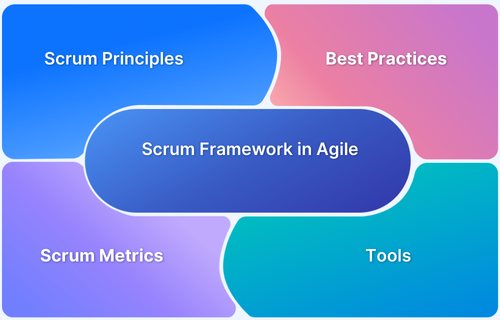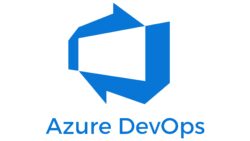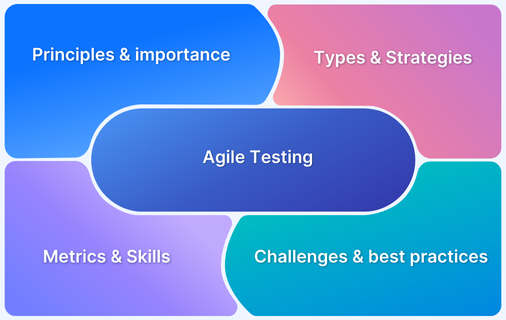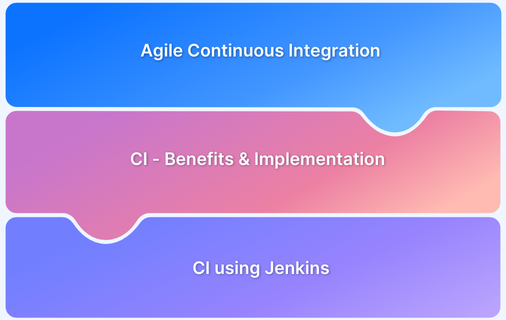The Agile Scrum framework is quite popular and is often used in startups and the software development industry to deliver a product quickly and improve it with each iteration.
Overview
What is Scrum Framework in Agile
Scrum Framework is a popular Agile methodology that provides a lightweight, iterative, and incremental approach to managing and completing complex software development projects. It prioritizes collaboration, flexibility, and continuous improvement.
Agile Scrum Framework Benefits
- Emphasize customer-centricity
- Facilitate Transparency
- Accelerate Product Delivery
- Improve Team Collaboration
- Drive Continuous Improvement
- Better Resource and Risk Management
This tutorial will take a closer look at the Agile methodology, the Scrum framework in Agile, Scrum Principles, and more.
What is Agile Methodology?
Agile methodology is an approach to project management that prioritizes splitting a project into smaller iterative cycles called sprints. The goal here is to deliver a working version of a product, which is improved upon at each phase based on customer feedback.
What is Scrum Framework in Agile?
The Scrum framework is a popular framework within the Agile project management methodology that enables small teams to collaborate, develop, and deliver software in clearly defined sprints.
In Scrum, the bulk of work is broken down into smaller tasks and delegated to team members. The team holds daily meetings (standups) to discuss the status of active tasks and blockers that may affect product delivery.
Read More: DevOps vs Scrum : Key Differences
Why is Agile Scrum Framework Important in Software Development?
The Agile Scrum framework is integral to software development, focusing on team collaboration, customer satisfaction, and quick product delivery.
The following reasons are why the Agile Scrum framework is important in software development:
- Customer Centricity: Scrum encourages ongoing interaction with customers and stakeholders to ensure their requirements and needs are met. It puts the customers’ happiness and satisfaction first.
- Transparency: The Scrum framework fosters transparency among all parties involved. Everyone is updated on the progress, issues, and blockers during software development.
- Team Collaboration: Organisations that adopt the Agile Scrum framework when executing projects experience better team collaboration and synergy towards the delivery of a project. This is enabled through daily standups and other Scrum ceremonies.
- Faster Product Delivery: This is possible because the framework prioritizes delivering a working software or feature after each sprint as the workload is split into smaller tasks and assigned to team members.
- Continuous Improvement: Suggestions and feedback about software products are easily incorporated into upcoming sprints after retrospectives and planning.
- Better Resource and Risk Management: The chances of a project failing after so much investment of resources are reduced because issues and blocks are identified during each sprint cycle. The software can be easily adapted to a better market fit based on customer feedback.
What are the Scrum Principles?
Like most project management methodologies and frameworks, Scrum provides six principles that serve as guidelines that must be followed during project execution.
Scrum Principles:
- Empirical Process Control
- Self-organization
- Collaboration
- Value-based prioritization
- Time-boxing
- Iterative Development
- Empirical Process Control: This means that experimentation and observation are relied upon untested theories or plans. This is founded on the ideas of transparency, inspection, and adaptation.
- Self-organization: Scrum promotes self-organizing teams, which implies that teams can make autonomous decisions on how best to accomplish a task. Each team member is also encouraged to take ownership of their work leading to greater productivity.
- Collaboration: At the core of the Scrum framework is interaction with team members and across different teams to achieve a common goal.
- Value-based prioritization: This principle ensures that work that delivers the most value to customers is ranked the highest and executed.
- Time-boxing: Here, tasks are planned, organized, and executed within a specific timeframe. Usually, in Scrum, a sprint spans for 2 weeks, within which a software feature is delivered.
- Iterative Development: Incremental product changes and improvements are made at each iteration/sprint.
Scrum Role and Responsibilities
There are three key roles in the Agile Scrum framework. This section explores each role and responsibilities in detail.
3 Key Scrum Roles
- Product owner
- Scrum master
- Development team.
- The Product Owner: The role of the product owner is very important in the Agile Scrum framework as he/she conveys the exact needs of the customer or market requirements to the development team. The product owner must understand the business and its value proposition to craft appropriate user stories, create a product backlog, and finally decide which feature should be implemented next.
- The Scrum Master: A Scrum master manages the Scrum process and ensures that its principles are adhered to by the team members. The duty of allocating resources (both human and logistical) for sprint planning, stand-up, sprint review, and the sprint retrospective rests with the Scrum master.
- The Development Team: The development team covers everyone, including software engineers, designers, etc., who get the actual work done. The team, which is often a small one, works together to deliver the product as guided by the scrum rules.
Scrum Events or Ceremonies
Scrum events or ceremonies are scheduled meetings where the development team, product owner, and scrum master plan work, discuss work in progress, highlight blockers, gather feedback, etc.
The Scrum framework has the following events or ceremonies:
- Sprint Planning: Just as the name implies, this meeting is scheduled at the start of a sprint, where teams set out goals to be achieved by the end of the sprint. The product owner, scrum master, and development team attend it.
- Daily Stand-up: This is a daily meeting of team members spanning about 15 minutes used to discuss task progression, identify blockers, and also keep the team in sync.
- Sprint Review: This meeting offers the opportunity for the team to review what was achieved in the just concluded sprint. During this meeting, a demonstration of the product is done and feedback is given which sets the tone for the upcoming sprint planning.
- Sprint Retrospective: The scrum meeting’s essence is to reflect on what has been done and figure out ways to keep improving what has been built so far. It promotes learning and a review of team dynamics, tools, and processes.
Scrum Artifacts
Scrum artifacts comprise all information tools used in the scrum process. It provides details on the product being developed, helping the team stay updated on what happens during the project.
There are three main scrum artifacts:
- Product Backlog: This is an ordered list of tasks, bugs, and features to be implemented in the product.
- Product Increment: This is a releasable product feature completed during a sprint that matches the customers’ needs.
- Sprint Backlog: It is an approved list of tasks that will be done within the sprint.
Scrum Metrics to Consider
Scrum metrics are measurable data points that provide a way to track the team’s efficiency and effectiveness and identify areas for improvement. Tracking scrum metrics can help the team gain valuable insights that enhance the implementation of the Agile Scrum framework.
Scrum Metrics
- Velocity
- Burndown
- Sprint Goal Success
- Customer Satisfaction
- Workload Distribution
- Technical Debt
Some of the scrum metrics to consider for tracking:
- Velocity: This defines the average amount of work done by a scrum team over several sprints. It shows how consistent the team has been over some time.
- Burndown: Burndown or burndown chart shows the remaining work (story points) during a sprint. It helps predict if a team is on track toward the completion of the sprint’s goal.
- Sprint Goal Success: This metric measures the team’s ability to reach each sprint’s goal. During sprint review, the team confirms whether the sprint goal was achieved or missed.
- Customer Satisfaction: One important metric to measure in scrum is customer satisfaction. This check reveals whether the customer is happy with the product or services offered. Regular check-ins are encouraged.
- Workload Distribution: This ensures that no team member is overworked or underutilized and that everyone takes on the number of tasks they can complete.
- Technical Debt: This refers to the resulting work that piles up because the team chose a cheap or quick solution over a more refined and thorough solution.
Role of Testing in Agile Scrum
Testing is an important aspect of software development, and it is rightly incorporated into the Agile Scrum process. The objective is to deliver quality-tested software that meets customer needs. The process is iterative, time-bound, and involves the use of testing tools.
Testers in the scrum development team should use tools that enhance efficiency and promote shorter testing cycles. Cloud testing platforms should be used to scale testing processes.
A cloud testing platform like BrowserStack offers features that enable the Scrum team to carry out testing faster and at scale. The BrowserStack Live and BrowserStack Automate provide testers with real devices for responsive testing across over 3500+ browsers and other testing infrastructure for test automation.
Tools for Implementing Agile Scrum
There are popular tools available that can help teams implement and track projects using the Agile Scrum framework. This section will highlight a few tools, including key features, pros, and cons.
Tools for Agile Scrum Execution
- BrowserStack Test Management
- Jira
- Trello
- Slack
- Confluence
- Azure DevOps
- GitHub
- Zoho Sprints
1. BrowserStack Test Management
In Agile Scrum execution, you need effective test management practices that integrate smoothly with development cycles. BrowserStack Test Management offers robust features to enhance test management in Agile Scrum environments.
Features:
- Centralized Test Management: All test cases, test plans, and test execution results are managed in a single platform, providing easy access and collaboration.
- Import Test Cases: Migrate your existing project data from platforms like Zephyr Scale or import data from CSV, or write test cases from scratch within the BrowserStack Test Management Tool.
- Collaboration: Features such as user roles, permissions, and comments enable collaboration among team members and stakeholders.
- Reporting and Analytics: Comprehensive reporting and analytics features provide insights into test coverage, execution status, and quality metrics.
- Integrations: BrowserStack Test Management can integrate seamlessly with CI/CD tools like Jenkins, Circle CI, etc., and with tools like BrowserStack Automate to help automated tests be triggered as part of the build pipeline.
Why Choose BrowserStack
- Manage Test Cases Seamlessly: Use BrowserStack to manage existing test suites or create a new one from scratch. Copy, move, edit, or delete test cases to improve their management.
- Get detailed performance reports, videos, and logs: Access and share comprehensive performance reports, videos, and logs with your team to debug and fix issues quickly.
- Scalability: Run concurrent performance tests for faster results.
- User-Friendly Interface: BrowserStack provides a robust, clean, and intuitive interface that helps navigate the tool easily.
- Test under real-world conditions: BrowserStack simulates real-world user conditions, such as varying network conditions and geolocations, to help you assess app performance in such scenarios.
2. Jira
Jira is a popular Agile Scrum project management tool used to track issues, report bugs, and plan and organize tasks.
Features:
- Teams can schedule and organize sprints with the sprint planning tools available on Jira.
- Scrum and Kanban boards help teams visualize and track tasks during a given sprint.
- The backlog prioritization feature helps teams rank and prioritize tasks based on their value.
- Integrations and marketplace add-ons boost interconnectivity with other project management tools.
Pros:
- Highly Customisable
- User-friendly interface
- Easy integration with other tools
Cons:
- Expensive
- Steep learning curve
- Time-consuming migration from other tools
- Reports cannot be downloaded
Read More: Best Test Management Tools For Jira
3. Trello
A minimalistic project management tool for managing workflow, projects, and tracking tasks with Kanban-styled boards.
Features:
- Offers an activity log to improve transparency by capturing what is done in real time.
- Kanban-styled boards and cards are used to manage and track assigned tasks to team members.
- Integration with other tools is seamless for better project management.
- Trello offers task tracking with labels, dates, and checklists.
Pros:
- Mobile friendly design
- Affordable pricing
- Seamless addition of new members
Cons:
- Lacks advanced features
- Limited customization
- Might not scale with large organizations with multiple projects
4. Slack
Slack is a work-and-productivity-focused communication platform for teams to share real-time communication and information.
Features:
- Ideas and discussion points can be captured with the easy note-taking feature.
- Custom shortcuts and commands allow for quick search for resources and navigation.
- The scrum team can huddle in audio and video calls for clear and direct communication.
- Channels are used to keep communication organized and focused on particular subjects.
Pros:
- Easy automation of tasks and integration with tools
- Enhances collaboration
Cons:
- Information overload
- Limited capabilities with a free plan
- Data breaches
5. Confluence
Confluence, often used with Jira, provides a platform for teams to create, collaborate, and organize work at a central point.
Features:
- A central place for project documentation where all project details and textual information are stored in one place.
- The file/media sharing feature allows team members to upload, delete, and share files.
- With project planning tools, team members can effectively manage and organize project tasks.
- Third-party app integration allows Confluence to be extensible beyond its current features.
- Templates for marketing plans and product requirement documents become starting points for creating various project documentation.
Pros:
- Central point for project knowledge base
- Promotes collaboration among team members
Cons:
- Limited features with a free plan
- No Kanban board
- Requires other third-party apps to attain full potential
6. Azure DevOps
Azure DevOps is a robust platform that brings together developers, project managers, and contributors towards the development of software by enforcing the Agile Scrum process.
Features:
- Teams can manage work items, collaborate effectively, and streamline workflow by using Azure Boards.
- With Azure Pipelines, project codebases can be automatically built, tested, and deployed hassle-free.
- Azure artifacts allow teams to store, manage, and share their packages while retaining access control.
- Azure Repos refers to a set of version control tools that you can use to manage your code.
- Managed DevOps pools automate the setup, scaling, and maintenance of agent pools.
Pros:
- Scalability and flexibility
- Seamless integration
Cons:
- Subscription cost
- Complexity
- Steep learning curve
7. GitHub
GitHub is a popular version control services platform based on Git that allows developers to collaborate, share, and store their code online.
Features:
- Users can track and manage changes to their code with version control via Git through CLI or a graphical user interface.
- Team collaboration is enhanced as developers can make pull requests and code reviews in real time.
- The bug/issue tracking feature helps the team improve software by identifying and debugging reported incidents of errors.
- Wikis serve as a point for creating relevant documentation about the software or codebase.
Pros:
- Reliable documentation
- Strong community
Cons:
- Steep learning curve
- Paywall for some advanced services
8. Zoho Sprints
Zoho Sprints is an online Agile project management platform for teams to deliver projects quickly through planning, tracking, and iteration.
Features:
- The software provides a backlog feature that helps the team prioritize tasks to be delivered.
- Timesheets keep a record of the time spent on each task by team members and could be a good data point to gauge team productivity.
- Teams can visualize and track progress on tasks by using a scrum board during sprints.
Pros:
- Simple and intuitive interface
- Customizable workflows, statuses, and fields
- Affordable for small teams
Cons:
- Slow customer response time
- Fewer third-party integrations
- Scalability problems for large teams
Challenges in implementing Agile Scrum Framework
Implementing an Agile Scrum framework might present some challenges to teams. This section highlights a few of those challenges.
- Resistance to change: The team may not be willing to let go of the traditional methodologies of operation in favor of the modern Agile Scrum framework.
- Lack of skills/knowledge gap: Scrum team members may not be well-versed in the Scrum framework and might require some training to boost productivity.
- Poor backlog management: The inability to rightly prioritize which feature gives the most value from the backlog will cause customers to be dissatisfied or result in a waste of time and resources.
- Ineffective sprint planning: When sprint planning events are not well executed, they often result in unachievable sprint goals.
Best Practices for Agile Scrum Framework
Here are some of the best practices that you can follow while implementing the Agile Scrum framework:
- Clearly define scrum roles and expectations as soon as possible
- Ensure that scrum ceremonies are adhered to and attended by all stakeholders
- Rank and prioritize user stories before each sprint
- Keep scrum ceremonies laser-focused and efficient
- Leverage the use of Agile project management tools and automate where necessary
How BrowserStack Supports Agile Scrum Testing?
Agile Scrum testing is an iterative process that is performed to validate the quality of software being developed.
BrowserStack supports Agile Scrum testing by providing a cloud-based environment where testers can have instant access to real devices and browsers for cross-browser testing.
The software being tested can undergo parallel automated tests on the BrowserStack platform. There is also the option of integration with CI/CD tools like Jenkins and GitHub Actions. Test reports can be shared with relevant team members based on insight generated on the platform.
Conclusion
The Agile Scrum framework is a popular project management framework mostly adopted in the software development industry. The framework provides a structure for executing the scrum process. However, it is not rigid and can be adapted as necessary.
Scrum principles and best practices must be adhered to to ensure that expected goals are achieved at each end of the sprint. Modern project management tools and infrastructure like BrowserStack can be leveraged to maximize fast-paced product delivery.
Useful Resources for Agile Methodologies
- Agile Development Methodologies: An Essential Guide
- All about Agile SDLC (Software Development Life Cycle)
- What is Agile Testing Know About Its Life Cycle, Types, and Metrics
- What is Agile Testing Quadrants: Why & How to Use It
- What is a Test Plan in Agile?
- How to Write Software Requirement Specifications in Agile
- Agile Testing Metrics that Every Tester Must Know
- 11 Agile Testing Challenges and its Solutions
- Debunking Myths about Agile Testing
- How BDD and Agile Together Make Testing Efficient
- Continuous Integration in Agile
- What does continuous delivery mean in agile?
- Risk Based Testing Approach for Agile Teams
- How to run Regression Testing in Agile Teams
- Role and Responsibilities of QA managers in Agile organizations
- Agile vs DevOps: What’s the Difference?
- Difference between CI and CD, Agile and DevOps
- Why Automation Testing is at the Centre of Agile Development








